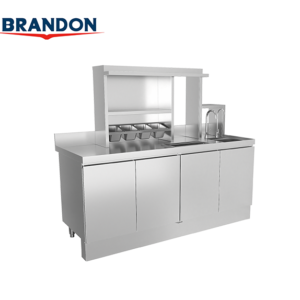BT10004 – Beverage Station
Dedicated place for tea tank, containers, measuring cylinder, water boiler, fructose dispenser
Description
| Model | Dimension(mm) |
|---|---|
| BT10004 | 2000 x 700 x (800+680) |
Well polished 304 stainless steel
Modules:GN pan holder, ice bin, storage cabinet, sink
The design of beverage stations varies based on the service type and beverage choices of different dining venues, such as fast-food outlets, coffee shops, upscale restaurants, and bars.
- High customer traffic demands efficient stations for swift service to minimize wait times, possibly incorporating self-service options and multiple preparation areas.
- The physical layout and size of the venue significantly influence station design, with limited spaces needing compact, multifunctional stations, while larger areas allow for more customization.
- The design reflects the venue’s brand and enhances customer experience through bespoke design and thoughtful layout.
- Operational efficiency and staff workflow are key, emphasizing easy-access storage and minimizing staff movement.
- Adherence to hygiene and safety standards affects material choice and equipment placement, prioritizing ease of cleaning and food safety.





